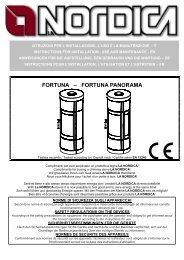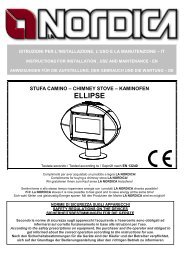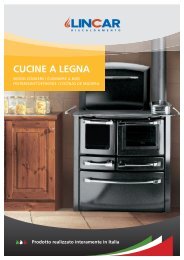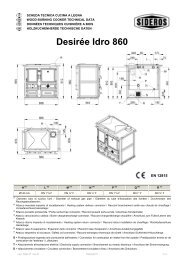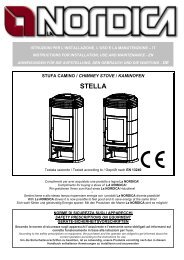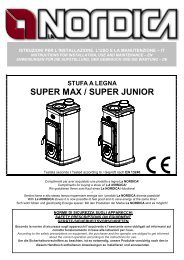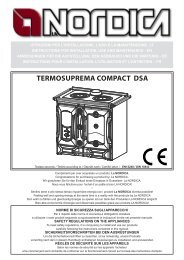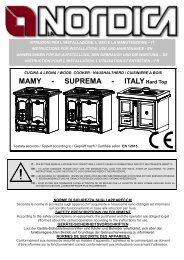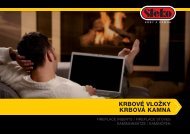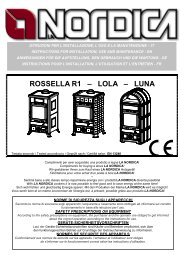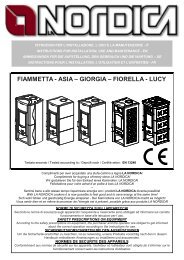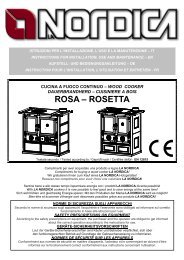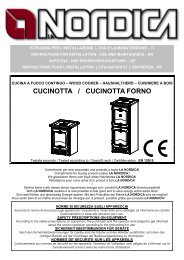MONOBLOCCO 400 PIANO - 500 ANGOLO – 800 ANGOLO / Dx - Sx
MONOBLOCCO 400 PIANO - 500 ANGOLO – 800 ANGOLO / Dx - Sx
MONOBLOCCO 400 PIANO - 500 ANGOLO – 800 ANGOLO / Dx - Sx
Create successful ePaper yourself
Turn your PDF publications into a flip-book with our unique Google optimized e-Paper software.
9. PERMISSIBLE/NON-PERMISSIBLE FUEL<br />
Monoblocco <strong>400</strong> Piano <strong>–</strong> <strong>500</strong> / <strong>800</strong> Angolo<br />
Logs are the permitted fuel. You should only use dry logs (max water content 20%). Logs should be about 30 cm in<br />
length and 30 cm in circumference.<br />
Compressed non-resinated logs must be used with caution to avoid overheating that may damage the device,<br />
as this type of wood features high heating value.<br />
Wood used as fuel must features less than 20% humidity content and be stored in a dry place. Damp wood does not<br />
burn well as a greater quantity of energy is required to make the water evaporate. Water content is also inconvenient<br />
insofar that, when temperature lowers, water condensates initially in the hearth and then in the stack, causing a<br />
considerable amount of soot to coat the stack and the potential risk of it catching fire.<br />
Fresh wood contains about 60% of H2O and is therefore unsuitable for burning.<br />
This wood should be kept in a dry ventilated place (e.g. under a shelter) for at least two years before use.<br />
A non-exhaustive list of non-permissible fuel: coal, trimmings, waste bark and panels, wet wood or wood<br />
treated with paints, plastics; use of this fuel will forfeit the device’s warranty.<br />
Paper and cardboard should be used to light the fire only.<br />
It is FORBIDDEN to burn waste as this can damage the device and flue, present a risk to health and, as it can<br />
produce a foul smell, lead to complaints by neighbours.<br />
Wood is not a long-lasting fuel so continuous heating throughout the night is not possible.<br />
Continuous and protracted use of wood particularly rich in aromatic oils (e.g. eucalyptus, myrtle, etc.) causes<br />
rapid wear (cleavage) of the cast iron components in the product.<br />
10. LIGHTING<br />
An unpleasant smell will invariably be produced when you light a fire in the hearth for the first time (due to drying of<br />
the sealant glue or protective lacquering), but this will soon wear off. You should however make sure the room is well<br />
ventilated.<br />
To light the fire we recommend you use small pieces of wood and paper or similar material available in the shops.<br />
It is FORBIDDEN to use any liquid agents such as alcohol, gasoline, oil and similar.<br />
Put in a small amount of fuel and open the (primary and secondary) comburent air vents.<br />
When the wood starts to burn, you can add more by opening the door slowly to prevent smoke from entering the<br />
room, close the primary air vent and control secondary air for combustion, following the instructions in Chapter 0.<br />
The hearth must be supervised during this entire phase.<br />
Do not light a fire in the hearth if there are combustible gases in the room.<br />
You should take the following notes into account when lighting a fire for the first time in a device treated with lacquers<br />
for high temperatures:<br />
• These products are built using non-homogenous materials such as cast iron, steel, refractory material and<br />
majolica;<br />
• The body of the product is subjected to non-homogenous temperature: temperatures can range from 300 to<br />
<strong>500</strong>°C according to its various parts;<br />
• There may be periods when fires are lit and extinguished on a regular basis, periods of intense use, or periods<br />
when the hearth isn’t used at all due to the season;<br />
• Several fires have to be lit in the hearth to allow all the device’s materials and lacquering to adjust to elastic<br />
stress and allow the device to be properly seasoned;<br />
• When you use the hearth for the first time, you will note the characteristic smell of the metal parts having to<br />
withstand extreme thermal stress and fresh lacquer. Although this lacquer is baked at 250° for several hours<br />
during the construction phase, it has to be brought up to 350° several times and for a good while for it to properly<br />
adhere to the metal surfaces.<br />
It is therefore important to take these small steps when lighting a fire:<br />
1) Make sure there is good air exchange in the room where the device is installed.<br />
2) At first, do not put too much fuel in the combustion chamber (about half the amount indicated in the instruction<br />
manual) and keep the fire continuously alight for at least 6 to 10 hours, and with the air regulators less open than<br />
indicated in the instruction manual.<br />
3) Repeat this procedure 4-5 times, or more if possible.<br />
4) Gradually use more wood at a time (still following the instructions on maximum capacity in the instruction<br />
manual) and keep the fire burning for long periods of time. Avoid, if possible <strong>–</strong> at least during initial use <strong>–</strong> fires of<br />
short duration.<br />
5) Do not lean anything against the device and especially not against lacquered surfaces during initial use.<br />
Do not touch the lacquered surfaces during the heating process.<br />
6) Once the device’s “break-in” phase has ended, use it as you would a car’s engine, avoiding abrupt heating by<br />
putting in too much fuel.<br />
26 6098401 Rev.09 <strong>–</strong> EN



